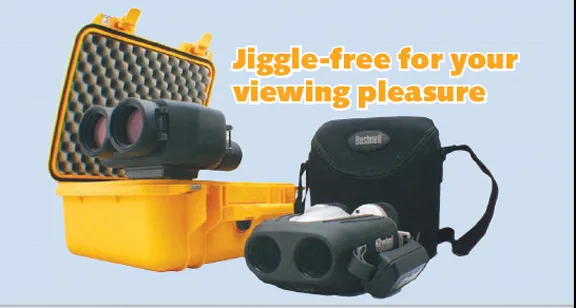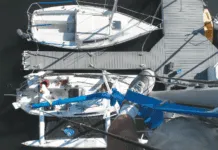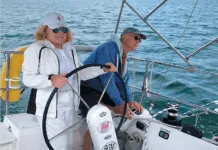All 14 binoculars tested for this years recent reviews (published August and November 2006) carried a magnification factor of 7×50. Why? Because 7x has proven to be the maximum practical magnification usable aboard a small boat. Any higher magnification and boat movement combined with hand jitters make the image unusable.
So whats the fix for getting a sharp image from high-magnification binoculars, like 10x, 12x, or even 16x, in the rock-and-roll environment of a boat at sea? Image stabilization (IS), a broad term for any technology that takes the shake out of an image.
When equipped with IS technology, modern binoculars can provide a clear, sharp image at magnifications more than double what most boaters have ever used on the water.

The high magnification of these binos makes them great for many applications, but theyre not ideal. Theyre heavier, less rugged, lack compasses, and require batteries. A good 7×50 marine binocular (like those we reviewed in the November issue) with a compass is better suited for daily use on a boat than an IS binocular. We wouldnt recommend buying image stabilized binos unless you already have a good 7×50 bino with compass on board.
For those boaters who are willing to spend a little more for the added features of an IS bino, we set out to determine which products offer the sharpest and clearest image.
WHAT WE TESTED
The group of IS binoculars assembled for this test range in price from $500 to $1,300, about the same range as our top-of-the-line, standard 7×50 binocular review. Magnification factor varied, too. We tested a pair of 10x units, the Bushnell 10×35 Stableview and the Canon 10×42 L IS WP. At 14x, we had the Fujinon TS 1040 Techno-Stabil and at 16x, our highest magnification unit, was the Nikon 16×32 StabilEyes.
BUSHNELL 10×35 STABLEVIEW
The Bushnell Stableview binoculars features a magnification factor of 10x, coupled with 35-millimeter objective lenses. The objective lenses and all the gadgetry needed to operate the stabilization are contained in a box-shaped case that tapers toward the front. The backside contains controls and eyepieces that adjust for interpupillary distance in tandem. Rubber eyecups twist in and out to accom-modate different users. Detents in the twist mechanism allow the eyecups to lock in one of four positions. To improve a users grip, the handholds are covered with textured black rubber. A hand strap on the left side doubles as a grip enhancer and a case for the pair of AA batteries re-quired for operation. Testers did not particularly like the external battery box in the hand strap, though it is adjustable. The Stableviews weigh in at 44.7 ounces.
Focusing is done using a single diopter on the right eyepiece and a center-focus knob on the top of the case. The diopter scale is only marked with a plus, minus, and an index. No numerical scale is provided. This binoculars are focused by using the center-focus knob with the right eye closed, and then with the left eye closed. Then refocus the right eye image with the diopter adjustment. All further focusing is done only with the center-focus.
Bushnell uses two piezo gyro vibration sensors (basically, a crystal that produces electrical signals when moved), one for the vertical axis and one for the horizontal axis, coupled with a pair of direct-drive motors to move a prism assembly in the desired direction to counter any binocular movement. A microprocessor controls the system.
Two modes of operation exist: Normal counters the long, slow rolling motion of a boat, while Fine counteracts handshake. Bushnell states the normal and fine modes have maximum correction angles of 3 degrees and 1 degree, respectively.
Two switches control the stabilization on the Bushnell binocular, while a tricolor LED light indicates readiness and mode. Power-up the unit by momentarily holding the power button until the LED flashes orange. The LED will continue to flash orange for five seconds while a self-test is completed. The LED will go steady orange to indicate standby and ready for operation modes. To activate stabilization in the normal mode, move the stabilization lever to active. A brief press of the power button switches between normal and fine modes.
We rated the Bushnell binocular Good for day/night viewing. Our testers were very impressed with the IS system. It provided enough stability to read the numbers on the channel markers at a distance of 1 nautical mile. (See How We Tested, above.)
The Stableview binocular comes equipped with a snug-fitting padded foam case and a 1-inch wide padded neck strap. This binocular is not equipped with any front lens covers.
Bottom Line: The Bushnell Stableview binocular offers surprisingly good performance for the price, garnering it our PS Budget Buy honor.
CANON 10×42 L IS WP
About a decade ago, Canon, world-renowned for its cameras and numerous other electronic devices, took the IS technology it originally designed for cameras and moved it into binoculars. The current incarnation of the companys IS binocular is sleek, armor coated, and use multi-coated lenses. Our test units eyepieces move together to adjust for the users interpupillary distance. Rubber eyecups twist in and out to accommodate eyeglass wearers. Movement of the eyepiece twist mechanism is smooth and stiff enough to lock into any of the four position detents provided.
The Canon is smaller than the other IS binoculars. Testers found it easy to hold, although with large hands your fingertips will touch on top of the unit. Access to the AA batteries is through a locking door in the bottom of the case. The Canon is the lightest binocular tested, weighing in at just over 40 ounces.
Focusing the Canon is done the same way as the Bushnell binocular, using the right eyepiece diopter and a center-focus knob on the top of the case. Testers found the center-focus knob very smooth and easy to operate with just one finger. The diopter has no numerical scale, but does lock into place once set. The Canon binocular earned the only Excellent focusing rating.
Canons IS system is called Variangle prism and claims a maximum correction angle of just under 1 degree. This system uses two sensors, one vertical and another horizontal, to detect pitch and yaw motion. They work in conjunction with a microprocessor that adjusts the Vari-Angle Prism on each side, in a bellows-type fashion, according to the amount of binocular shake detected. This provides instant adjustment of the refraction angle to compensate for motion.
Pressing a single button instantly turns on the Canon IS system, and an LED light on top indicates that its operating. A second button push turns the IS system off; if you forget to power-down, the system will turn off automatically when the binocular is face down (as it would be when carried with the neck strap) for a predetermined time.
The Canon binocular received a Good rating for day/night viewing. Though our testers thought this binocular provided a sharp image, the Canon IS system did not cope with the pitching and rolling boat nearly as well as the best of the test units. Testers were able to read the channel markers clearly at 5,000 feet, but had difficulty reading the numbers on the navigation markers at the 1 nautical mile distance. Canon ships this binocular with a padded, zipper-lock case, objective lens covers, eyepiece covers, and a neck strap with a 2-inch-wide pad for the back of the neck.
Bottom Line: The Canon is the smallest, lightest, and best looking of the bunch. It has the longest warranty too. However, the IS capabilities fall short in our estimation.
FUJINON TECHNO-STABI 14×40
The third generation Fujinon Techno-Stabi binoculars in this test feature a magnification factor of 14x coupled with 40-millimeter objective lenses. Black rubber armor coating in combination with a polycarbonate case offer a degree of impact protection for the lenses and electronics. The rear case panel holds a pair of adjustable eyepieces, the battery case release, and, in the upper right-hand corner, the focus knob. The range of interpupillary distance adjustment is not as high as some of the other binoculars, however, in testing, we did not find this to be an issue. Four AA batteries located in a latched compartment on the bottom of the binocular case supply power for the electronics. Two different option kits allow the user to power these binoculars from either the ships AC or DC.
Rubber eyecups extend back from the ocular lenses and must be folded down to accommodate eyeglass wearers. A removable hand strap fits on either side of the case. Our testers preferred the Fujinons with the neck strap installed and no hand strap. The Fujinon Techno-Stabi binocular are the heaviest of the test units, weighing 47.5 ounces. Still, that is only 7 ounces heavier than the lightest IS binocular in our test.
The Fujinons focus like the Canon and Bushnell, using the right eye-piece diopter and the focus knob. We found the focus knob a bit hard to turn with one finger.
Fujinon uses the most sophisticated stabilization system of all the binoculars tested. It utilizes input from two piezo gyro vibration sensors, one for the vertical axis and one for the horizontal axis, to detect cyclical and repetitive motion. Plus, it uses the input from another pair of gyro sensors, again one on the vertical axis and one on the horizontal axis, to detect binocular direction. These four inputs are sent to a microprocessor that sends output signals to a pair of direct drive motors that instantaneously move the gimbaled erecting prism to correct for any movement. Fujinon, in the owners manual, says the system will correct for up to 5 degrees of motion in either direction. Our testers found the Fujinon IS system to be superior to the others tested.
Two switches located on the top, left-hand side of the case control the stabilization on the Fujinon binocular. An LED facing the user indicates condition. Power-up the IS system by momentarily pressing the power button. A second press activates the system. Youll know its working by the electric-motor sound that emanates momentarily from the case. The LED glows green when the IS system is op-erating. A brief press of the power-off button shuts down the system.
The was the only unit to garner an Excellent rating for day/night viewing. The IS system in the Fujinons held the image steadier than the others and allowed our testers to read several markers that were beyond 1 nautical mile from the test boat.
Fujinon ships the Techno-Stabi binocular in a custom-fitted Pelican hard case for the ultimate in storage protection. A wide, padded neck strap is also standard. This binocular is not equipped with any front lens covers.
Bottom Line: A superior IS system coupled with good quality optics garnered the Fujinon the only Excellent day/night viewing rating. The Fujinon Techno-Stabi binocular is our top pick.
NIKON 16×32 STABILEYES
The StabilEyes main body is covered with black plastic armor that is textured on the bottom and indexed for fingers on top. The back panel on the main body holds controls and a pair of eyepieces. The eyepieces adjust for interpupillary distance in tandem. Rubber eyecups twist in and out to accommodate different users and eyeglass wearers. Detents in the twist mechanism allow the eyecups to lock in one of four positions. An adjustable hand strap on the left side doubles as a grip enhancer and case for the pair of AA batteries required for operation. As we mentioned before, wed prefer having a removable hand strap. The StabilEyes weigh in at 42.1 ounces.
As with all the other test binoculars, focusing is done using the right eyepiece diopter and a focus knob located on the top center of the case. No numerical markings are provided in the diopter scale. Nikons IS system is called Vibration Reduction (VR) and uses piezo gyro vibration sensors coupled with a pair of direct-drive motors to move a gimbaled prism assembly with an erecting prism that counteracts vibration and binocular movement. Nikon claims a maximum correction angle of 3 degrees.
Three switches control the stabilization on the Nikon binoculars with a pair of LED lights to indicate status. To power-up, hold the power button until the LED near it flashes amber. This LED will continue to flash amber for five seconds while a self-test is completed. Once this LED goes to steady amber, the unit is ready for operation. To activate stabilization, move the stabilization lever to on. On top of the unit, another pushbutton allows the user to momentarily suspend IS operation by pressing the VR pause button. An LED on top of the case illuminates when the button is pressed.
Testers rated the Nikon binoculars Good for day/night viewing. We could read the channel markers at 5,000 feet clearly, but had some difficulty at 1 nautical mile. It seemed to us that the plus or minus 3 degree IS correction angle is not quite enough when coupled with the high magnification of the 16x StabilEyes.
Nikon ships the StabilEyes binocular with a padded case that closes with a small Velcro lock and a nylon strap with plastic locking clips. A nicely padded, 2-inch-wide neck strap is standard, too. The StabilEyes is not equipped with any front lens covers.
Bottom Line: Good, but not as sharp as the Fujinons. The external battery compartment makes them clunkier to use than others.
CONCLUSIONS
Testers found the Fujinon IS system to be so much better than the others that it had to be singled out as our top pick. However, the one-year warranty is too short. With all the precise optics, mechanisms, and microelectronics in a product like this, wed like to see the warranty extended to at least two years.
Bushnell pleasantly surprised us with its Stableview binocular. It performed well overall, carries a two-year warranty, and is priced right.
CONTACTS
BUSHNELL
800/423-3537
bushnell.com
CANON
800/oK-cANoN
usa.canon.com
FUJINON
973/633-5600
fujinon.com
NIKON
800/645-6678
niknonusa.com




































